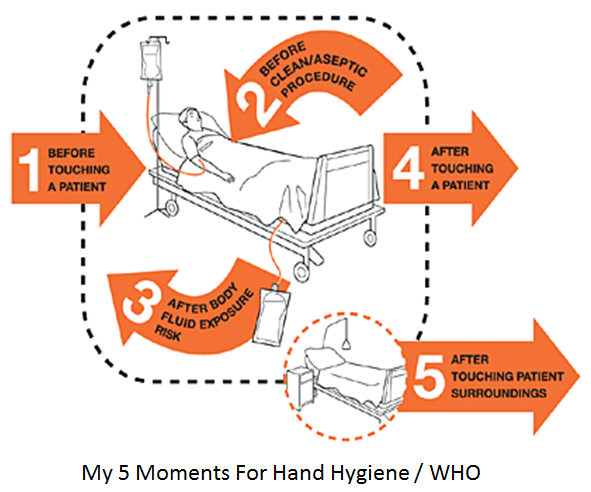Hand Hygiene Day: The Key to Fighting Antibiotic Resistance Is in Your Hands
Today, May 5th, is Hand Hygiene Day, a day that reminds healthcare workers, visitors, and policy makers alike, that frequent handwashing can be used to fight the growing threat of antibiotic resistance, and ultimately, save millions of lives.
One of the strongest ways to prevent the spread of infections is by making sure that your hands are clean. Each year, on May 5th, we recognized on a global scale Hand Hygiene Day, a day that underscores just how important frequent handwashing can be, especially as the threat of antibiotic resistance continues to grow. The theme for this year? “Fight Antibiotic Resistance—It’s in Your Hands.”
The World Health Organization (WHO) stresses the importance of this day, because it plays a role in promoting good infection prevention and control practices in order to change behavior. If the end goal is to reduce the spread of infections, particularly in hospitals or healthcare facilities, practitioners and visitors alike need to be more mindful of their actions; to strengthen prevention practices, behavior change is imperative.
Although advancements are constantly being made in infection prevention, WHO reports that 1 in 10 patients will get a healthcare-associated infection (HAI) while receiving care.
“Healthcare-associated infections are one of the most frequent adverse events in healthcare delivery, and are a major public health problem that affects hundreds of millions of people worldwide,” Mahmoud Fikri, PhD, WHO Regional Director for the Eastern Mediterranean region said in a press release.
About 32% of patients who have undergone surgery and are receiving care get post-operative infections; about half of those patients (51%) “are resistant to treatment with antibiotics.” Due to this, WHO’s campaign for Hand Hygiene Day this year focuses on fighting antibiotic resistance.
WHO calls on policy makers to make infection prevention and hand hygiene practices a “national policy priority” to reduce the number of these infections. Furthermore, WHO is also calling on countries and healthcare facilities to strengthen infection prevention and control programs based on WHO’s guidelines on core components for infection prevention, of which hand hygiene is a key player, to fight antibiotic resistance.
WHO reports that about 70% of healthcare workers and 50% of surgical teams do not routinely practice hand hygiene, which underscores a substantial opportunity for improvement, especially since hand hygiene can not only reduce the risk of HAIs, but could potentially “save 8 million lives every year in hospitals alone.”
At the Society for Healthcare Epidemiology of America (SHEA) Spring 2017 Conference, co-chair of the Scientific Spring Program at the SHEA Spring Meeting, Matthew Linam, MD, MS, associate professor, Department of Pediatrics at the University of Arkansas, and medical director of Hospital Epidemiology and Infection Control at Arkansas Children’s Hospital (ACH), examined methods to prevent the spread of respiratory viral HAIs by healthcare workers in healthcare settings. According to Dr. Linam, proper hand-hygiene practices for healthcare workers are “the most important behavior to prevent HAIs.” Although guidelines defining proper hand hygiene have been provided by the Centers for Disease Control and Prevention (CDC) and WHO, “we don’t do near as good a job as we should.”
So, what are the central moments when healthcare workers should remember to clean their hands? If taking the “My 5 Moments for Hand Hygiene approach,” healthcare workers should perform hand hygiene:

In honor of World Hand Hygiene Day, the CDC is also promoting a campaign called “Clean Hands Count,” which, according to their website, aims to:
- Improve healthcare provider adherence to CDC hand hygiene recommendations
- Address the myths and misperceptions about hand hygiene
- Empower patients to play a role in their care by asking or reminding healthcare providers to clean their hands
Hand hygiene is one of the more critical practices where patients are starting to become more active. For example, one form of engagement could be to monitor hand hygiene practices among healthcare workers in the facilities where they are receiving care.
In fact, at the SHEA Spring 2017 Conference, Heather Schact Reisinger, PhD, MAA, medical anthropologist, associate director for Research and Core Investigation for the Center for Comprehensive Access and Delivery Research and Evaluation (CADRE) at the US Department of Veteran Affairs, discussed the importance of patient engagement in HAI prevention programs.
“As far as effectiveness, engaged patients report higher quality and fewer errors, have reduced healthcare utilization and costs, and have a positive impact on health outcomes, [such as] increased medication adherence, reduced rates of hospital admissions and reduced lengths of stay, [and] increased preventative care,” she said.
Practicing hand hygiene frequently and correctly is a simple yet effective way to make a difference in infection prevention and transmission. After all, like WHO says, “Clean hands make the health system a safer place to receive care.”
